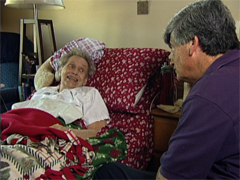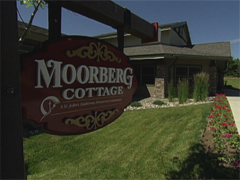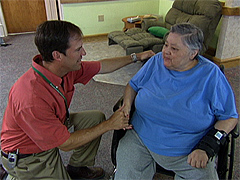Green House Nursing Homes
BOB ABERNETHY, anchor: There’s a hopeful new development on the nursing home scene. Investors, among them faith-based groups, are building and staffing small cottages in which those needing long-term care can get personal attention and find a degree of independence that’s not possible in most larger institutions. Bob Faw of NBC News has our report.
BOB FAW: This can be the cruelest time — of dependence, of loneliness, their frailty magnified. Sharing the music with no one, they often feel cast aside, isolated as they navigate the empty corridors of a large nursing home. It doesn’t have to be like this.
FAW: Nearly 90, Caroline Ackerman, who flew ferry B-24’s to Army pilots in World War II, was moved from a large nursing home to this new cottage into a private, comfortable room with her special pal Maggie.
Ms. ACKERMAN: It’s wonderful. In fact that was the agreement: that I would come if I could bring my Maggie because she is pretty important to me.
FAW: Ninety-six-year-old Madeline Childs also lives in the same house where she can go to the kitchen whenever she wants to make her favorite — a peanut butter and jelly sandwich.
MADELINE CHILDS (Green House Resident): I think that’s enough.
FAW: These “elders,” as they are called here, are living not in an institution, a large nursing home, but in one of the so-called Green Houses. There are eight homes here run by St. John’s Lutheran Ministries in Billings, Montana. Each houses no more than 12 residents. Each is designed to feel and look like home.
MIKE FOLLETT (St. John’s Lutheran Ministries): When you drive up to the nicest place maybe that you have ever lived in or seen and it feels like a cottage or home…
FAW (to Mr. Follett): You want to move in?
Mr. FOLLETT: You want to move in. And it creates that nurturing environment that the institution does not provide.
FAW: Designed not just to look comfortable but to make elders inside feel comfortable and independent.
 Mr. FOLLETT: It’s about recreating the culture of long-term care in America. It’s a system that’s broken. No human being wants to end up in an institutional nursing home. A big institution, no matter how nice the carpet, how good the food, is still a scary place for any human being when they become frail at the end stage of their life.
Mr. FOLLETT: It’s about recreating the culture of long-term care in America. It’s a system that’s broken. No human being wants to end up in an institutional nursing home. A big institution, no matter how nice the carpet, how good the food, is still a scary place for any human being when they become frail at the end stage of their life.
FAW: It’s home to 82-year-old Irene Rader who once traveled the country with her celebrated husband fiddler Grant Rader. Unlike in many big nursing homes, Irene doesn’t have to share a room with anyone or conform to a strict schedule. She can listen to her husband’s music whenever she wants. She can also surround herself with the many paintings she has made, some of her favorites like Donkey Dylan. And she can come and go as she pleases.
IRENE RADER (Green House Resident): They’re really good to me. The food is good and I go to bed when I want to and get up when I want to.
FAW (to Ms. Radar): You live your own life?
Ms. RADAR: I live my own life.
FAW (to Ms. Radar): That’s the point, isn’t it?
Ms. RADAR: Yes it is.
FAW: Nationwide there are 31 Green House homes. Over 140 new ones are planned. Most have been built by faith-based organizations like Mike Follett’s St. John’s Lutheran Ministries.
Mr. FOLLETT: Ironically, this model is starting with faith-based organizations across the country. And I think that is appropriate because it takes incredible perseverance, commitment and faith to pull this off.
FAW: While everyone seems to agree the present system is broken, that housing seniors in sterile institutions is both depressing and doesn’t work, there are skeptics about what is being tried here. They are worried these cottages might not be ideal for the very frail, that capital costs are enormous and that Medicaid doesn’t begin to cover all the operating costs. Administrators admit this is not easy. State nursing home regulators, for example, still make cottages conform to costly standards set for big facilities.
Mr. FOLLETT (speaking during meeting): My favorite is the range hood in the kitchen that belongs in the Bellagio Casino in Las Vegas. This thing was a $15,000 extra cost.
FAW: The cost per person in a cottage is roughly $209 a day compared to about $190 in the nearby nursing home. But faith-based organizations say these Green Houses are close to breaking even, and they argue they can even be operated at a profit.
Mr. FOLLETT: This new model requires fewer resources, a condensed structure, but far more hours and quality-time with the elderly than we could ever give in an institution. So, in theory, it should work.
FAW: In big nursing homes the annual staff turnover rate ranges averages around 76 percent. But in the last three years the St. John’s homes have lost only three people, in part, says Green House guide Nancy Fee, who mentors, trains and supports the staff, because caregivers here are responsible for running the homes.
NANCY FEE (Green House Guide): We have empowered them to make decisions within their household. And so they take the responsibility of planning their menus, ordering their food, deciding what, what do the elders want.
FAW: Caregivers prepare the meals which are served whenever the elders want to eat. No pre-assigned routines, no kitchen shutting down at set times. For 85-year old Phyllis Southard that means getting the food she likes.
PHYLLIS SOUTHARD(Green House Resident): My specialty has been eggs with a little bit of cheese on it — a slice of cheese. And that’s good.
FAW: Caregivers not only prepare the meals.
KAYLA BRACCIALE (Caregiver): Right here Tom. I’ve got a chair for you.
FAW: They also sit down and eat with the elders — helping them, sharing the way families do.
Ms. BRACCIALE: You know, your whole life you eat with family and you converse and some of these people are hard of hearing, and they can’t hear. So I thought if I go sit next to her and hold her hand, she’ll start eating. And she did. I have been doing this for two-and-a-half years and I love it. I wouldn’t trade it for anything in the whole entire world.
FAW: Some worry these cottages aren’t suitable for the frail. But in fact the elders often do better in a small environment because they are more closely watched. For them, large institutions can be stressful because of…
Ms. FEE: Over-stimulation; too much noise; pots and pans; people going up and down the hallways; phones ringing.
Mr. FOLLETT: We have people who weren’t eating. When they get into this new environment, they’re eating again. People who weren’t able to recognize their family members, within a week of moving into the new cottage they’re remembering their spouse again.
FAW: Tom Passe, for example. When he came here from a big nursing home, he was withdrawn, almost mute. Now his sister, Gladys Houser, marvels at the change.
GLADYS HOUSER: We talked to three people yesterday on the phone. And I could just see his eyes just light up and knew he was in the same space with them, that he remembered and he knew who he was talking to. He remembered the good times together.
FAW (to Ms. Houser): And do you attribute this in part to him moving here?
Ms. HOUSER: I do. Yes, he is a different person here.
FAW: St. John’s is planning on opening five more Green Houses by 2009.
Mr. FOLLETT: Hi Solly.
SOLLY (Green House Resident): Hey Mike, how are you doing?
FAW: The Green House concept, says the nursing home industry, is working well. So this may be the future: a Lutheran institution, directed by a one-time physical therapist who just happens to be Catholic — ministering in the broadest sense.
Mr. FOLLETT: This is ministry at the core of the human element, in my opinion. Letting the frailest gifts be recognized and to soar again, after they’ve been squelched at the end stage of life — it represents the definition of ministry in my heart and soul.
FAW: Repairing a system that is broken — protecting, nurturing and sustaining elders in a leap of faith.
For RELIGION & ETHICS NEWSWEEKLY, this is Bob Faw in Billings, Montana.




